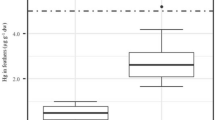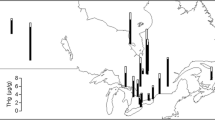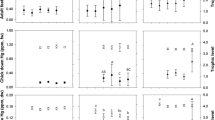Abstract
We assessed mercury levels in the feathers of little tern (Sternula albifrons) chicks from hatching to fledging and in their prey captured by adults in three main foraging habitats: lagoon, salinas, and adjacent sea. These data were used to model mercury concentration in chick feathers through food ingestion, in order to explore the effects that changes in diet would have on the mercury burden of chicks as they aged. The mercury concentration in feathers of chicks raised in sandy beaches was higher than in those raised in salinas. Lagoon prey had a significantly higher mercury concentration (0.18 ± 0.09 μg g−1 dry weight [d.w.]) than prey from salinas and the adjacent sea (both 0.06 ± 0.03 μg g−1 d.w.). In relation to prey species group, mercury content was significantly higher for bottom fish (0.17 ± 0.10 μg g−1 d.w.) than for pelagic (0.08 ± 0.06 μg g−1 d.w.), euryhaline fish (0.04 ± 0.02 μg g−1 d.w.), and crustacea (0.08 ± 0.03 μg g−1 d.w.). To understand the importance of mercury content of each prey group, we ran several theoretical scenarios assuming that chicks were fed on only one species at a time. Considering a diet restricted to lagoon (mostly benthic) prey, A- and B-chicks may encounter health problems with an excess of mercury. On the contrary, a diet restricted to marine (mostly pelagic) prey would decrease the mercury concentration in chick feathers; the fast growth rate and the related mercury dilution effect in little tern chicks seem to decrease mercury levels in their feathers. Our study supports the fact that marine pelagic prey are important for estuarine seabirds because they provide a food resource with lower contamination levels. This model may have a wider application in similar seabird species and coastal environments.





Similar content being viewed by others
References
Allcorn R, Eaton MA, Cranswick PA, Perrow M., Hall C., Smith L, Reid J, Webb A, Smith KWS, Langston RHW, Ratcliffe N (2003) A pilot study of breeding tern foraging ranges in NW England and East Anglia in relation to potential development areas for offshore windfarms. RSPB/WWT/JNCC, Sandy
Arcos JM, Ruiz X, Bearhop S, Furness RW (2002) Mercury levels in seabirds and their fish prey at the Ebro Delta (NW Mediterranean): the role of trawler discards as a source of contamination. MEPS 232:281–290
Bearhop S, Waldron S, Thompson DR, Furness RW (2000) Biamplification of mercury in great skua Catharacta skua chicks: the influence of trophic status as determined by stable isotope signatures of blood and feathers. Mar Pollut Bull 40(2):181–185
Becker PH (1992) Egg mercury levels decline with the laying sequence in charadriiformes. Bull Environ Contam Toxicol 48:762–767
Becker PH, Furness RW, Henning D (1993a) Mercury dynamics in young common tern (Sterna hirundo) chicks from a polluted environment. Ecotoxicology 2:33–40
Becker PH, Furness RW, Henning D (1993b) The value of chick feathers to assess spatial and interspecific variation in the mercury contamination of seabirds. Environ Monit Assess 28:255–262
Becker PH, González-Solís J, Behrends B, Croxall J (2002) Feather mercury levels in seabirds at South Georgia: influence of trophic position, sex and age. Mar Ecol Prog Ser 243:261–269
Becker PH, Henning D, Furness RW (1994) Differences in mercury contamination and elimination during feather development in gull and tern broods. Arch Environ Contam Toxicol 27:162–167
Benton MJ, Mallot ML, Trybula MJ, Dean DM, Guttman SI (2002) Genetic effects of mercury contamination on aquatic snail populations: allozyme genotypes and DNA strand breakage. Environ Toxicol Chem 21(3):584–589
Bogliani G, Fasola M, Canova L, Saino N (1994) Prey selection by parents and chicks of the little tern Sterna albifrons. Avocetta 18:9–11
Borga K, Campbell L, Gabrielsen GW, Norstrom RJ, Muir DCG, Fisk AT (2006) Regional and species bioaccumulation of major and trace elements in artic seabirds. Environ Toxicol Chem 25:2927–2936
Braune BM (1987) Comparison of total mercury levels in relation to diet and molt for nine species of marine birds. Arch Environ Contam Toxicol 16:217–224
Burger J, Gochfeld M (1997) Risk, mercury levels, and birds: relating adverse laboratory effects to field monitoring. Environ Res 75:160–172
Burger J, Gochfeld M (2002) Effects of chemicals and pollution on seabirds. In: Schreiber EA, Burger J (eds) Biology of marine birds. CRC Press, Boca Raton, FL
Burger J, Gochfeld M (2004) Marine birds as sentinels of environmental pollution. EcoHealth 1:263–274
Catry T, Ramos JA, Catry I, Revez M-A, Grade N (2004) Are salinas a suitable alternative breeding habitat for little terns? Ibis 146:247–257
Catry T, Ramos JA, Martins J, Peste F, Trigo S, Paiva VH, Almeida A, Luís A, Palma J, Andrade P (2006) Intercolony and annual differences in the diet and feeding ecology of little tern adults and chicks in Portugal. Condor 108:366–376
Cramp S (1985) The birds of the western Paleartic. Vol 4. Oxford University Press, Oxford
Custer TW, Hines RK, Melancon MJ, Hoffman DJ, Wickliffe JK, Bickham JW, Martin JW, Henshel DS (1997) Contaminant concentrations and biomarker response in great blue heron eggs from 10 colonies on the upper Mississippi River, USA. Environ Toxicol Chem 16:260–271
Davies S (1981) Development and behaviour of little tern chicks. Br Birds 74:291–298
Dietz R, Riget F, Cleemann M, Aarkrog A, Johansen P, Hansen JC (2000) Comparison of contaminants from different trophic levels and ecosystems. Sci Tot Environ 245:221–231
Fasola M, Bogliani G (1990) Foraging ranges of an assemblage of Mediterranean seabirds. Colon Waterbirds 13(1):72–74
Fowler J, Cohen L, Jarvis P (1998) Practical statistics for field biology. Wiley, New York, p 259
Furness RW, Camphuysen KCJ (1997) Seabirds as monitors of the marine environment. ICES J Mar Sci 54:726–737
Goutner V, Furness RW (1997) Mercury in feathers of little egret Egretta garzetta and Night Heron Nycticorax nycticorax chicks and in their prey in the Axios Delta, Greece. Arch Environ Contam Toxicol 32:211–216
Goutner V, Furness RW, Papakostas G (2001) Mercury in feathers of squacco heron (Ardeola ralloides) chicks in relation to age, hatching order, growth and sampling dates. Environ Pollut 111:107–115
Gray JS (2002) Biomagnification in marine systems: the perspective of an ecologist. Mar Pollut Bull 45:46–52
High Performance Systems, Inc. (1997) Getting started with the STELLA software. A hands-on experience. High Performance Systems, Inc., Hanover, NH
Jarman WM, Hobson KA, Sydeman WJ, Bacon E, McLaren EB (1996) Influence of trophic position and feeding location on contaminant levels in the Gulf of the Farallones food web revealed by stable isotope analysis. Environ Sci Technol 30:654–660
Kenow KP, Gutreuter S, Hines RK, Meyer MW, Fournier F, Karasov WH (2003) Effects of methyl mercury exposure on the growth of juvenile common loons. Ecotoxicology 12:171–182
Konarzewski M, Kooijman S, Ricklefs E (1998) Models for avian growth and development. In: Starck JM, Ricklefs RE (eds) Avian growth and development. Oxford University Press, New York
Lewis SA, Furness RW (1991) Mercury accumulation and excretion in laboratory reared black-headed gull Larus ridibundus chicks. Arch Environ Contam Toxicol 21:316–320
Lewis SA, Furness RW (1993) The role of eggs in mercury excretion by quail Coturnix coturnix and the implications for monitoring mercury pollution by analysis of feathers. Ecotoxicology 2:55–64
Madenjian CP, Gabrey SW (1995) Waterbird predation on fish in western Lake Erie: a bioenergetics model application. Condor 97:141–153
Massias A, Becker PH (1990) Nutritive value of food and growth in common tern Sterna hirundo chicks. Ornis Scand 21:187–194
Monteiro LR, Furness RW (1995) Seabirds as monitors of mercury in the marine environment. Water Air Soil Pollut 80:851–870
Monteiro LR, Furness RW (2001) Kinetics, dose-response, excretion and toxicity of methylmercury in free-living Cory’s shearwaters chicks. Environ Toxicol Chem 20(8):1816–1823
Monteiro LR, Furness RW, del Nevo AJ (1995) Mercury levels in seabirds from the Azores, mid-North Atlantic Ocean. Arch Environ Contam Toxicol 28:304–309
Monteiro LR, Granadeiro JP, Furness RW (1998) Relationship between mercury levels and diet in Azores seabirds. Mar Ecol Prog Ser 166:259–265
Monteiro LR, Granadeiro JP, Furness RW, Oliveira P (1999) Contemporary patterns of mercury in the Portuguese Atlantic inferred from mercury concentrations in seabird tissues. Mar Environ Res 47:173–156
Muir D, Braune B, DeMarch B, Norstrom R, Wagemann R, Lockhart L, Hargrave B, Bright D, Addison R, Payne J, Reimer K (1999) Spatial and temporal trends and effects of contaminants in the Canadian Artic marine ecosystem: a review. Sci Tot Environ 230:83–144
Paiva VH, Ramos JA, Catry T, Pedro P, Medeiros R, Palma J (2006a) Influence of environmental factors and energetic value of food on little tern chick growth and food delivery. Bird Study 53:1–11
Paiva VH, Ramos JA, Machado D, Penha-Lopes G, Bouslama MF, Dias N, Nielsen S (2006b) Importance of marine prey to growth of estuarine tern chicks: evidence from an energetic balance model. Ardea 94:241–255
Paiva VH, Ramos JA, Martins J, Almeida A, Carvalho A (2007) Foraging habitat selection by little terns Sterna albifrons in an estuarine lagoon system of southern Portugal. Ibis (in press)
Ramos JA, Solá E, Monteiro LR, (1998) Prey delivery to roseate tern chicks in the Azores. J Field Ornithol 69:419–429
Schew WA, Ricklefs RE (1998) Developmental plasticity. In: Starck JM, Ricklefs RE (eds) Avian growth and development. Oxford University Press, New York
Sokal RR, Rohlf FJ (1995) Biometry. 3rd ed. Freeman Press, New York
Starck JM, Ricklefs RE (1998) Patterns of development: the altricial-prcocial spectrum. In: Starck JM, Ricklefs RE (eds) Avian growth and development. Oxford University Press, New York
Stewart FM, Phillips RA, Catry P, Furness RW (1997) Influence of species, age and diet on mercury concentrations in Shetland seabirds. Mar Ecol Prog Ser 151:237–244
Stienen EWM, Brenninkmeijer A (2002) Variation in growth in sandwich tern chicks Sterna sandvicensis and the consequences for pre- and post-fledging mortality. Ibis 144:567–576
Tavares PC, Monteiro LR, Lopes RJ, Pereira ME, Duarte AC, Furness RW (2005) Mercury contamination of little tern Sterna albifrons chicks in South-west Europe. Brood, age and colony related effects. Bull Environ Contam Toxicol 74(1):177–183
Thompson DR, Furness RW (1989a) The chemical form of mercury stored in South Atlantic Seabirds. Environ Pollut 60:305–317
Thompson DR, Furness RW (1989b) Comparison of the levels of total and organic mercury in seabird feathers. Mar Pollut Bull 20(11):577–579
Thompson DR, Furness RW, Monteiro LR (1998) Seabirds as biomonitors of mercury inputs to epipelagic and mesopelagic marine food chains. Sci Tot Environ 213:299–305
Thyen S, Becker PH, Behmann H (2000) Organochlorine and mercury contamination of little terns (Sterna albifrons) breeding at the western Baltic Sea, 1978–96. Environ Pollut 108(2):225–238
Wenzel C, Adelung D, Theede H (1996) Distribution and age-related changes of trace elements in kittiwake Rissa tridactyla nestlings from an isolated colony in the German Bight, North Sea. Sci Tot Environ 193:13–26
Acknowledgment
We are grateful to David Max and two anonymous referees for valuable comments on a draft version of the manuscript.
Author information
Authors and Affiliations
Corresponding author
Rights and permissions
About this article
Cite this article
Paiva, V.H., Tavares, P.C., Ramos, J.A. et al. The Influence of Diet on Mercury Intake by Little Tern Chicks. Arch Environ Contam Toxicol 55, 317–328 (2008). https://doi.org/10.1007/s00244-007-9118-x
Received:
Accepted:
Published:
Issue Date:
DOI: https://doi.org/10.1007/s00244-007-9118-x




